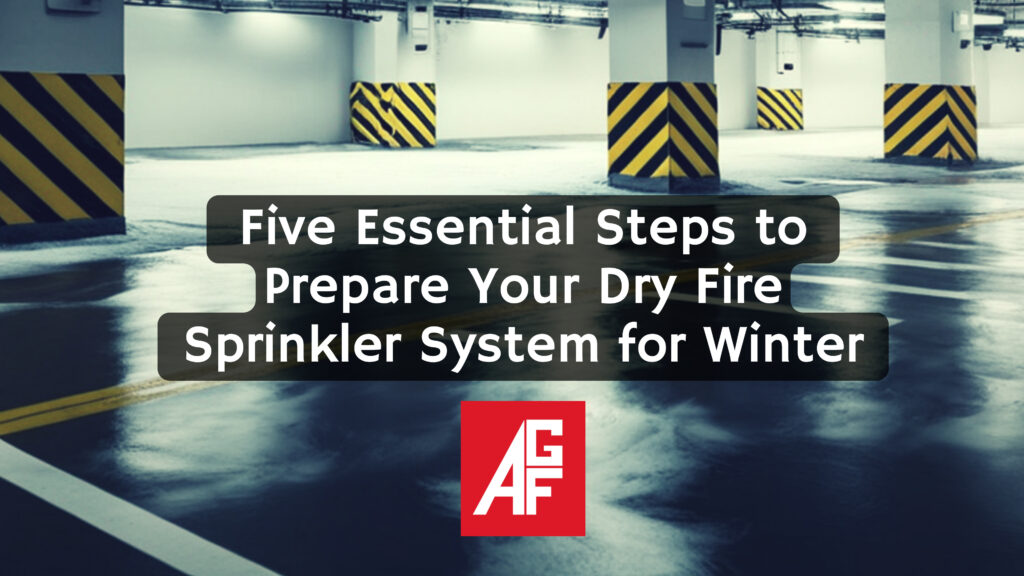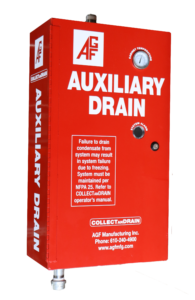
“An ounce of prevention is worth a pound of cure.” Benjamin Franklin
Benjamin Franklin’s timeless wisdom applies perfectly to the challenges of maintaining dry fire sprinkler systems through the harsh winter months. Every year, building owners and facility managers face frozen drains, damaged piping, system downtime, and costly repairs, all of which are preventable with the right preparation.
The key to avoiding those headaches lies in one word: prevention.
When temperatures drop, water trapped in auxiliary drains, aka low points, can freeze, expand, and crack the drain, releasing pressure from the system and tripping the dry valve. The result? Flooded spaces, impaired fire protection, and expensive emergency service calls. But with a few proactive steps and the right tools from AGF Manufacturing, facility teams can protect their systems and their budgets from winter’s worst effects.
Understanding Dry Fire Sprinkler Systems and Winter Risks
Dry fire sprinkler systems are used in areas where freezing temperatures make wet systems impractical: warehouses, parking garages, attics, loading docks, and unheated spaces. Instead of water, these systems are filled with pressurized air or nitrogen that holds a dry pipe valve closed. When a sprinkler head activates during a fire, the valve opens, releasing water into the system and through the activated sprinkler.
While effective, these systems are not entirely “dry.” Over time, condensation forms inside the piping due to temperature fluctuations and humidity in the compressed air. That moisture naturally settles at the system’s low points inside auxiliary drains, also known as low-point drains.
If not drained regularly, that collected water can freeze, expanding and bursting pipes, fittings, and valves. Even a small amount of ice can break a drain or damage valve seat, compromising components.
Why Winterization is Essential
Each winter, fire protection contractors and facility managers across North America respond to frozen or ruptured dry sprinkler systems. The resulting water damage and downtime can cost thousands of dollars, not to mention the risk of having an impaired fire protection system during freezing weather.
Common winter-related issues include:
- Frozen auxiliary drains that split or crack when ice expands
- Loss of system air pressure from leaks caused by ice damage
- Corrosion from standing water that was not fully drained
- Frequent nuisance alarms or impaired conditions that take systems offline
Proper winterization minimizes these risks. A well-maintained system not only prevents property damage but also ensures compliance with NFPA 25 inspection and maintenance requirements.
Five Essential Steps to Prepare Your Dry Fire Sprinkler System for Winter
- Inspect and Seal the Building
Before temperatures drop, inspect all windows, doors, and wall penetrations in areas containing sprinkler piping. Even small drafts can quickly lower the temperature in mechanical rooms or attics. Ensure openings are sealed, doors close tightly, and insulation remains intact to maintain a stable environment.
Pro Tip: Don’t overlook stairwells, dock doors, and roof hatches, common sources of cold air infiltration.
- Verify Insulation Coverage
Proper insulation helps stabilize temperatures and reduce rapid swings that cause condensation buildup. Ensure insulation is in good condition and covers all exposed areas, especially near exterior walls and ceilings.
Replace any damaged or missing insulation as soon as possible. Pay close attention to areas around hangers or fittings, where insulation can shift or degrade over time.
- Service the HVAC System
Your building’s heating system plays a critical role in protecting the fire sprinkler system. Schedule HVAC maintenance early in the season to confirm heaters are operational and thermostats are calibrated correctly.
If the dry system runs through partially heated areas, consider installing temperature monitors or alarms to warn of drops below freezing. Even a brief failure of the heating system can cause major problems if the air temperatures around sprinkler piping drop too low.
- Inspect Air Compressors and System Pressure
As outdoor temperatures decrease, so does air pressure. Regularly check the system’s compressor, air dryer, and supervisory air pressure to ensure proper operation.
An air leak can go unnoticed during warmer months but lead to a system trip or freeze-up in winter. Verify that air dryers are removing moisture effectively; any excess humidity in the compressed air supply contributes to condensation within the system piping.
Pro Tip: Use a maintenance checklist to track system pressure readings and compressor cycles throughout the season. Inconsistent readings may indicate leaks or equipment issues that need attention. Consider installing General Air Products Dry Air Pac generators for moisture-sensitive installations.
- Drain All Auxiliary Drains (Low-Point Drains)
This step is arguably the most important after a system activation or before freezing temperatures. Auxiliary drains are designed to collect condensation and residual water that accumulates in low sections of the piping network. During cold weather, even a small amount of trapped water can freeze solid, causing the drain or the surrounding pipe to rupture.
Each auxiliary drain should be emptied regularly throughout the winter, not just during initial winterization. NFPA 25 requires draining of all low points after each system trip and as needed when condensation is present.
Routinely check for water accumulation and ensure drains are completely emptied. If drains are located in unheated or hard-to-access areas, consider upgrading to a heated auxiliary drain or automatic drain for continuous protection.
Simplify Winter Maintenance with AGF Solutions
AGF Manufacturing offers a complete line of products designed to make winterization and ongoing maintenance simpler, safer, and more reliable. Whether you’re managing one facility or hundreds, these solutions help prevent freeze and flooding damage, reduce service calls, and ensure your system stays operational all year long.
COLLECTanDRAIN® Auxiliary Drains
The COLLECTanDRAIN® line provides a smarter way to manage low-point drains. Preassembled and easy to install, COLLECTanDRAIN units are designed for long-term durability and minimal maintenance.
Models include heated cabinet versions that protect the drain from freezing, allowing for easy access and servicing even in unconditioned spaces. By keeping auxiliary drains warm and dry, these units dramatically reduce the risk of freeze-related failures and save time during inspections.
Key Benefits:
- Preassembled for faster installation and retrofits
- Heated cabinet models prevent freeze-ups
- Easy visibility and maintenance access
- Available in multiple configurations, including auto-draining (Model 5500).
Flood Eliminator®
Freeze-ups or accidental valve openings can lead to uncontrolled water discharge from a broken auxiliary drain. The Flood Eliminator® is designed to  prevent that.
prevent that.
This automatic safety device is installed above an auxiliary drain and slows the flow of water out of a broken drain. It lowers the risk of slip and fall accidents for frozen discharge and helps prevent catastrophic property damage.
Key Benefits:
- Prevents water discharge from damaged drains
- Installs easily on new or existing low point drains
- Helps minimize property damage during freeze events
AGF Connect™ Remote Monitoring
AGF Connect represents the next generation of fire sprinkler maintenance. Using wireless sensors and indoor or outdoor gateways, AGF Connect allows contractors and facility managers to remotely monitor auxiliary drains for  service needs.
service needs.
The system provides real-time alerts when water is present, helping prevent freeze damage before it happens. There’s no need to connect to a fire alarm panel or building management system; AGF Connect operates independently and can send alerts to multiple email addresses, phone, app, and cloud-based dashboard.
For contractors, AGF Connect means fewer site visits and proactive maintenance scheduling. For facility managers, it offers peace of mind that auxiliary drains are being serviced before there is an issue.
Key Benefits:
- Real-time remote monitoring of auxiliary drains
- Alerts when drains need service
- No connection to fire panel or BMS required
- Reduces emergency calls and maintenance costs
Putting It All Together: A Winterization Checklist
Here’s a quick recap of actions to take before temperatures drop:
- Inspect doors, windows, and penetrations for drafts
- Confirm insulation is intact and adequate
- Service HVAC and heating systems
- Check the compressor, air dryer, and system pressure
- Drain all auxiliary drains and keep them empty
- Inspect or upgrade drains to heated COLLECTANDRAIN® models
- Consider installing AGF Connect™ for remote monitoring and alerts
Prevention Pays Off
Winter maintenance may feel routine, but the cost of skipping it can be severe. A single frozen auxiliary drain can cause thousands of dollars in damage, disrupt operations, and impair fire protection when it’s needed most.
By taking proactive steps, supported by AGF’s purpose-built solutions, facility managers and contractors can protect systems, prevent costly breakdowns, and ensure reliable performance throughout the winter.
Remember Franklin’s advice: “An ounce of prevention is worth a pound of cure.” In fire protection, that ounce of prevention can save more than just money; it can preserve safety, property, and peace of mind.
